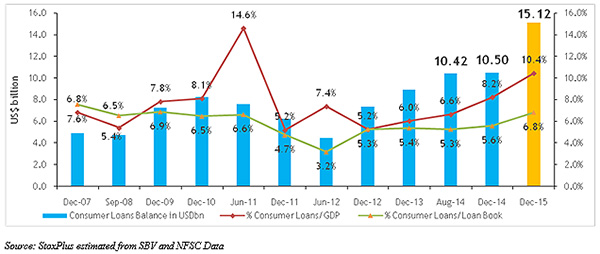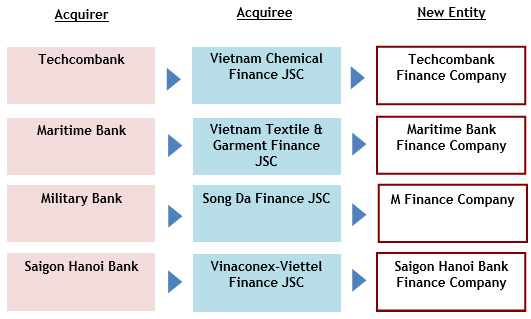FinTech - Solution or Challenge to Vietnamese Consumer Finance companies?
Following a robust surge in 2014, Vietnam’s Consumer Finance Market in 2015 continued to experience the fastest growth for the past 5 years. The outstanding loan balance soared from $10.5 billion in December 2014 to $15.12 billion at the end of 2015, signifying 44.1 per cent growth.
Figure 1: Consumer Loan Balance ($bn), %Consumer Loans/GDP, %Consumer Loans/Loan Book

According to StoxPlus’s analysis, the robust growth of the Vietnamese Consumer Finance Market resulted from the significant change in customer behaviour and the middle class’respectively high demand for housing loans. The transition in the borrowing behaviour of customers from borrowing from relatives, friends or the informal finance market to more formalized methods at finance companies also had a positive implication on the lending market.
Despite the favourable environment, the Vietnamese Consumer Finance Market has become more and more competitive with an increasing number of participants. Indeed, the market landscape in 2015 has experienced the acquisition of many local finance companies by Joint Stock Commercial Banks as well as the fast growth of local CF companies, like FE Credit. The market is predicted to be gradually dominated by local companies, as VP Bank Finance Company is taking over the first place from Home Credit in terms of outstanding loans, accounting for more than 50 per cent of the total market share of CF companies.
As the number of players doubled this year, while the number of Point-of-Sales (POS)is limited, buyers’ bargaining power will be high. Incentives or commission will be raised in order to secure a place at POS. Taking Mobile World and FPT Shop for example, there are at least 4 consumer finance companies, including FE Credit, Home Credit, HD Saison, and ACS, located in one shop. Therefore, the profit margin of such CF companies will be unquestionably reduced.
Figure 2: Closed M&A Deals in Vietnam Consumer Finance Market by the end of 2015

Source: StoxPlus
Furthermore, the sales channels of CF companies also suffered from the challenges of higher sales and operation expenses from collection & payment third party companies, like MoMo and Payoo. In particular, these third party companies will charge a fee of 5 to 8 per cent per collection or payment transaction, which also led to the reduction of CF companies’ profit.
Traditional Consumer Finance Market facing steepest challenges yet—Will “Going Digital” tip the scales?
FinTech is a term used to describe companies that apply innovative technology in the Financial Servicesindustry. 2015 marked a boom of FinTech in Vietnam, with MoMo and Payoo as the popular mobile payment apps being used by many CF companies and the emergence of new players, like LoanVi. Banks like VP Bank also introduced mobile banking app Timo, which expects to innovate banking and lending practices. These companies are changing the payment industry and creating a new era of applying technology to the lending business in Vietnam.
The benefit of FinTech is that theycan leverage technology in order to revolutionize sales channels and provide more convenience, accessibility, and tailored products for customers. Even though CF companies are still relying on Point-of-Sales, the mobile channel is considered to be the next big thing. FinTech companies can thus provide a user-friendly and time-saving mobile platform for financial transactions and pioneer untapped markets, including the unbanked, undeserved, and youth segments of the population.
Even though FinTech companies only provide a payment platform and limited lending activities at the moment, they are expected to rise to be a threat to CF companies. By utilizing their competitive advantages, such as an extensive network and a large client database, payment companies, such as MoMo, Payoo or BankPlus, have many incentives to enter the consumer finance market. Therefore, CF companies who fail to catch up with technology innovations will likely fall behind in the next few years.
Nowadays, when people talk about the successful leveraging of innovative technology into businesses, people immediately think about Uber or Amazon. In order to be the next “Uber moment” in the Consumer Finance industry, FinTech companies will need to overcome many challenges, including making their products and brand well-known, earning the trust of customers, as well as dealing with the lax and slow process of regulation formation for FinTech companies in Vietnam.
What the stars mean:
★ Poor ★ ★ Promising ★★★ Good ★★★★ Very good ★★★★★ Exceptional
Latest News
More News
- F88 partners with MB to transform over 850 financial stores into bank offices (December 17, 2024 | 18:04)
- Obstacles to stock-market upgrade to be removed (December 17, 2024 | 11:29)
- Vietnam seizes opportunities amid global trade shifts (December 16, 2024 | 18:00)
- Long-term perspective remains optimal approach (December 16, 2024 | 14:26)
- Fiscal measures to be based on upcoming US status (December 16, 2024 | 10:09)
- PetroVietnam accelerates divestment from PVI (December 16, 2024 | 06:59)
- Techcombank proactive with ESG and sustainability (December 14, 2024 | 10:00)
- VAT cut set to continue on through to summer (December 14, 2024 | 09:00)
- BIWASE Long An issues Vietnam's first AAA-rated bonds worth $27.6 million (December 13, 2024 | 20:22)
- Citi hosts Vietnam Day for Hong Kong clients (December 13, 2024 | 14:21)



















 Mobile Version
Mobile Version